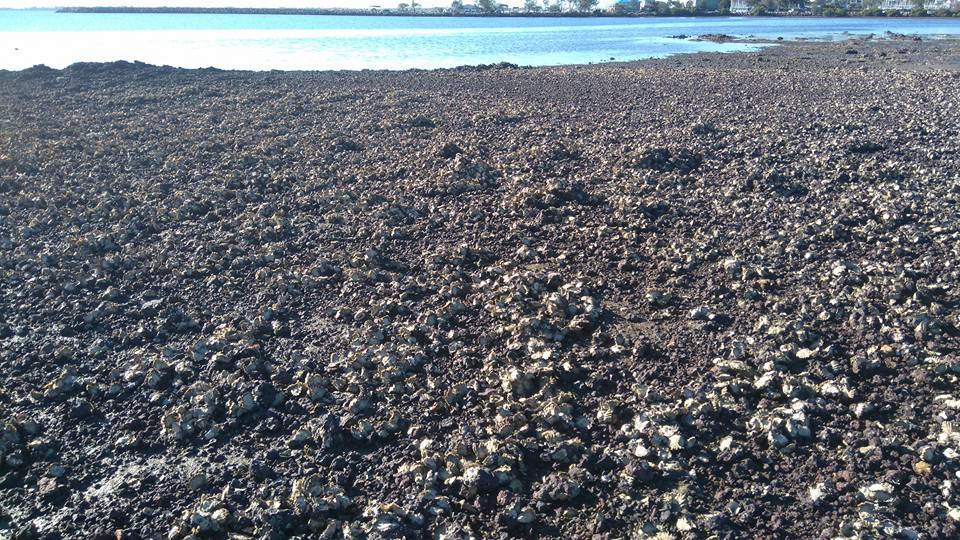|
|
Intertidal molluscs on unconsolidated or unknown substrateShort descriptionIntertidal mollusc beds on unconsolidated or substrate of unspecified consolidation. Disclaimer: Ecosystem type descriptions are based on biophysical attributes identified in Central Queensland through expert advice and supported by scientific literature. Not all ecosystem types are mapped based on current inventory, and many of the ecosystems described here may also occur in other parts of Queensland.
Classification categoriesSelect from the links below to view related ecosystem type categories Long descriptionIntertidal mollusc beds that do not occur on consolidated substrates, includes razor clams (Pinna bicolour), leaf oysters (Isognomon ephippium) or mussels (Trichomya hirsuta) growing on mud, sand, gravel or boulder substrates. Fourteen species of bivalve mollusc are known to form shellfish reef ecosystems, with their extent in Queensland poorly known[1]. Other shellfish ecosystems grow on, or form, consolidated ecosystem types. Also includes commercially grown oysters (Ostraeidae) Saccostrea cucullata (milky oyster) and Saccostrea glomerata (rock oyster)[1] where they occur on gravel (including cobbles and/or pebbles). These ecosystems may also include encrusting algae, erect macrophyte algae and bryozoans, and mussel beds may include sponges. See types (64, 65, 116, 118). Special valuesThere is currently very limited information available regarding the extent, physical characteristics, biodiversity and ecosystem services of Australian shellfish ecosystems, particularly those in unconsolidated sediments and not of commercial importance. Oysters and mussels are ecosystem engineers that create shellfish reefs that provide, modify and maintain habitats for a range of other species. Shellfish reefs provide a range of ecosystem services, including food provision, fish and invertebrate habitat, water filtration, fish production and shoreline protection. For thousands of years, Traditional Owners caught and ate large numbers of shellfish species in and around the Queensland coast. See type (116) for further values information. Diagnostic attributesInundation 'Intertidal – Lower low', 'Intertidal – Mid low', 'Intertidal – Upper low', 'Intertidal – Low undifferentiated', 'Intertidal – Lower medium', 'Intertidal – Upper-medium', 'Intertidal – Medium undifferentiated', 'Intertidal – High', 'Intertidal – Undifferentiated', 'Intertidal – High undifferentiated' although usually occurring below mean sea level Structural macrobiota 'Molluscs – other', 'Molluscs – oysters', 'Molluscs – scallops', 'Other fauna – barnacles' Consolidation 'Intermediate', 'Unconsolidated', 'Unknown' QualifiersBoth attributes of Structural macrobiota and Sediment texture may have been modified by previous harvesting of oysters but this modification is unmapped. DistributionLittle inventory for the state to date. Mussels, ark shells and sponges formed aggregations in Moreton Bay that may persist but are unsurveyed. The following relates to distribution of this ecosystem type within the Central Queensland mapping area:
CommentsOther relevant attributes include Energy and Sediment texture as mollusc beds typically develop in muds and fine sediments in low energy environments. Additional InformationMolluscs - Museum of Tropical Queensland Shellfish Reef Restoration Network References
Last updated: 22 July 2019 This page should be cited as: Department of Environment, Science and Innovation, Queensland (2019) Intertidal molluscs on unconsolidated or unknown substrate, WetlandInfo website, accessed 25 June 2024. Available at: https://wetlandinfo.des.qld.gov.au/wetlands/ecology/aquatic-ecosystems-natural/estuarine-marine/descriptions/20/ |

 — Department of Environment, Science and Innovation
— Department of Environment, Science and Innovation


